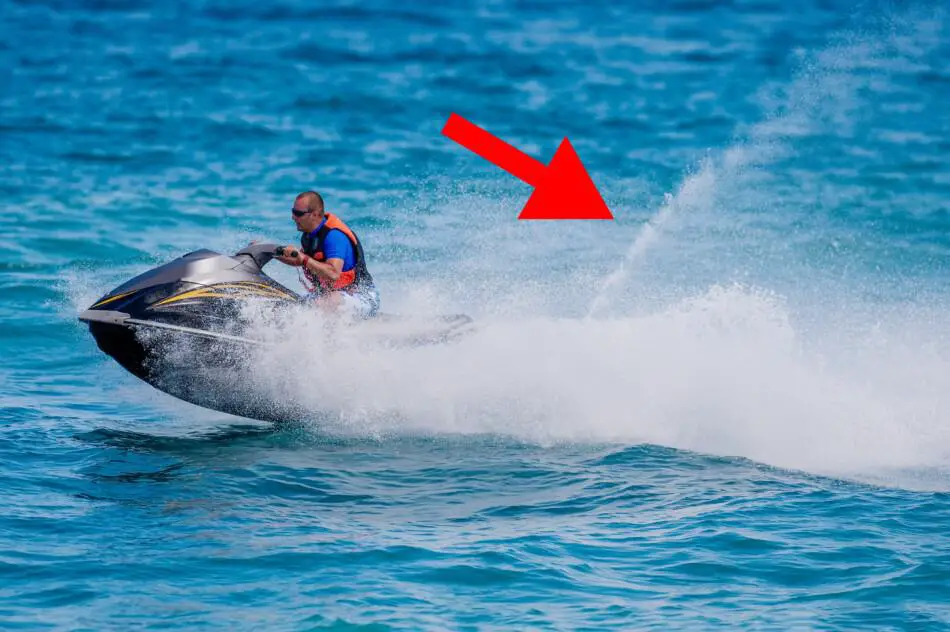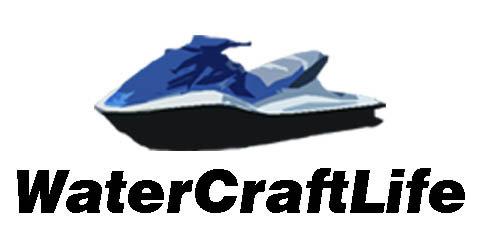
When you are out on the water, do you notice that the back of some jet skis shoot a stream of water up into the air? That narrow stream of water shooting upward, also known as the rooster tail, is unique to Yamaha brand jet skis and is found on no other brands.
Jet skis shoot water up in the air for two reasons, visibility and looks. First, it is for safety, in the chop, the 10′ spray alerts other boaters that there is a jet ski nearby. This is especially important on rough days. Second, this is unique only to Yamaha as they have patented the spray.
Read ahead for more details that dispel the mystery of how the rooster tail is engineered and why it’s unique to Yamaha jet skis.
How Jet Skis Function
Understanding the design of jet skis will help you understand why jet skis shoot water into the air through their visibility spout.
PWC Engines
Jet skis are special because the power behind their movement in water resides inside of the craft.
At the bottom of the jet ski, you will find a grated intake vent used by the motor to suck up water. The engine uses fuel to power the impeller, think of it as an internal propeller within a pipe, to eject high-pressure water out of the back. You may also hear this called an inboard motor, unlike the outboard motor you find on crafts with propellers on the outside like boats.
The inboard gasoline motor of the jet ski powers the jet water pump. When the nozzle in the back of the craft powerfully releases the water out of the craft, it thrusts the jet ski forward in the water. The higher the throttle, the stronger the pressure is in the pump and results in a strong spray of water.
Jet Skis need Cooling
Another function of the water that’s sucked into the jet ski is to keep the engine cool as it is in a confined area. A high-powered vehicle like a jet ski needs a defense in place to prevent overheating, so the water moving through the jet ski acts as one safeguard.
Other watercrafts use a similar system of inboard motors because the water absorbs heat and eliminates the need for radiators.
Now, what’s special to note is that other brand name jet skis do not expel a narrow stream of water from this system up and into the air. Instead, other brands like Sea Doos or Kawasakis propel water out of the rear or side and parallel to the water.
Yamaha’s jet skis shoot this coolant water up and into the air. You will hear some people call this the rooster tail.
The Rooster Tail: Special to Yamahas
Yamaha has two things in mind when designing their jet skis to include a high and visible stream of water to shoot up and into the air. One reason is for rooster tail is safety, and the other reason is assumed to be a trademark style. Other names PWC riders call this is the visibility spout or even the pisser.
Safety
The water that shoots up from the back of the craft, the rooster tail, increases the jet skis visibility to other boaters while in the water. Imagine how much smaller a jet ski is in comparison to other watercrafts. Danger presents itself if you find yourself behind rough water and bigger waves where a boat may not see you.
Having a nozzle that shoots water upward of 10 feet allows others to see you from a difficult position or from farther distances. Others on the water will be cautious and avoid you.
Think of it as the tall bright sand flag on off-roader vehicles like dune buggies and quads or even the cyclist who wears reflective gear on paved roads. Their purpose is to signal their location to others.
If you are wondering why you haven’t had this safety feature on a jet ski you’ve seen or been on before, that is because the majority of jet ski brands do not include a rooster tail in their design. Some users of Yamaha jet skis also opt to disable the rooster tail.
Branding
Yamaha is unlike other name brand jet skis that keep the rear nozzle where water exits parallel to the water. Instead, Yamaha prefers the trademark style of shooting water up and into the air. Yamaha has the exclusive rights to this design.
Design Reception
You will find some that some jet ski users that strongly prefer a rooster tail because of the design and the safety it provides.
On the other hand, you will definitely find others that are unimpressed and annoyed. They argue that the rooster tail serves no purpose except for brand recognition.
Drawbacks
Many don’t see the value in having a rooster tail. Since the water streams up into the air, you can run into situations where it becomes problematic for yourself and the riders in your group.
For instance, the chances of someone being hit with water when you pull them on a wakeboard or tube are much greater. I will be the first to tell you that this is very annoying.
Depending on the wind and the strength of waves of waves you will face, you can also be hit with water if you are doing sharp turns or manouvers.
If you are riding with other jet skis, you may hit them with your spray causing a loss of visibility for that rider.
Jet ski users are also limited with space in the rear of the craft, so a rooster tail can obstruct the amount of items you can store because the spray of water happens on the rear platform.
I have a Yamaha Superjet and the spray is nice as it gives you a nice foot massage, but the spray is not nice when you get a jet up your backside. Ouch!
How to disable your Yamaha Visibility Spout
If you choose to disable your visibility spout as you are annoyed, or want to load a cooler on your PWC deck, it is easy to do and can be reconnected.
- First, look under your jet ski at the hose that connects the spray and disconnect.
- Second, you can leave it dangling, but if you choose, zip tie it to another item near your pump. Make sure it is not a moving item to not rip the hose out.
Getting rid of your spout is as easy as that.

